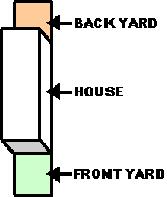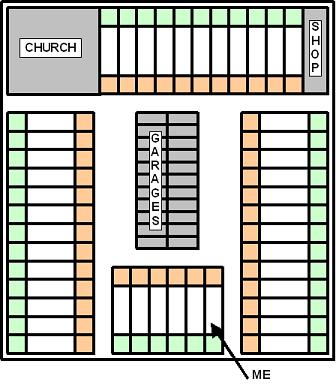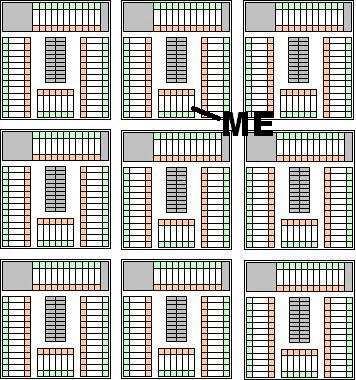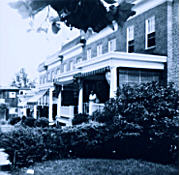A
Bug on a Tile...
I've been reflecting recently on my
lifelong interest in collecting.
I've collected lots of things over the years: stamps & coins, comic books,
Sci-Fi paperbacks, LP records, animal skulls, rocks & minerals, pottery, and
more recently, "standard" 12-oz. beer glasses with logos on them, 30 X 40 mm
cabochons, and cancelled stock certificates. Next year it may well be
something new.
If I can identify one characteristic of a collection that interests me, it is
the simple fact that each individual unit within any given collection set is
"self-similar" to all the other units. This may seem like a moot point, a
tautology. Sure, that defines the concept of a collection, doesn't it? But it
seems especially significant to me that each unit in a set has roughly the
same dimensions, aspects, shapes or attributes. At a distance, they may all
look the same. But the critical point is that they are not the same;
intimate inspection reveals a positive uniqueness to each item. And the items,
while each having an individual character, definitely belong together with the
others that surround them. Ideally, they mesh perfectly.
I don't consider myself a particularly anal-retentive person -- as I suspect
most "true" collectors are. I am not aware of any particular issues with my
early potty training. I had a somewhat uneventful, but generally happy
childhood. I am slightly introspective, but pleasant and sociable enough when
around others. I pay my taxes and bills when due, and obey the law. My private
thoughts are generally cheerful and optimistic.
As to my collections: I don't assign any particular, inherent value to them --
other than a vague feeling of comfort I have when I am amidst the collected
articles. I don't clutch the items greedily to my breast and giggle madly, or
spread them on the carpet and, like Scrooge McDuck, swim through them like a
porpoise. If you were to visit me and express interest in any particular
collected item, I am very likely to give it to you gratis, on the spot.
For, having been "fully collected", an item's value is somewhat less than it
was during the hunt, the kill, the bagging and the dressing. Plus I always
have more than enough items in any of my collections to keep me happy.
I particularly enjoy the act of cataloging my collected items, and equally so
in packaging and, ultimately, storing or displaying them. If they are display
items, I am likely to spend an inordinate amount of time constructing custom
acrylic showboxes, or procuring particularly attractive commercial containers
to isolate them and set them off. There is a peak of momentary excitement when
I label or otherwise physically identify and/or finally index an article. I
would not associate it with a sexual feeling, except in a metaphorical sense.
The "labeling" moment is usually the final step in series of loving actions
performed with each unit item; in this sense it is comparable to the
culmination of a long, slow, pleasurable round of lovemaking. Of course, the
comparison breaks down when you consider that, while I tenderly touch and
handle the physical items, they never touch back.
What I have described is just the surface pattern of this behavior. There is
something deeper at its core. And now, in the later stages of my life, I may
be starting to figure out just what that something is. In truth, I feel drawn
not only to the types of things that I collect, but to any set of self-similar
objects that I run across. What I am describing here is any group, or even
pictures of a group, consisting of shapes, articles, sounds, colors or items
that are almost -- but not quite -- identical to each other. I tender the
following examples, wherein each article in the set has very subtle
distinctions that makes it a little bit unique. These kinds of scenarios
literally fascinate me:
o Andy Warhol's "repetitive image" silkscreens
o A whole tableful of mason jars with perfectly-placed
okra or string beans inside,
arrayed for judging at a County Fair
o A glass jar full of jellybeans (preferably all of
the same color)
o A repetitive "groove" section in a James Brown song
o A neatly sown field of corn, a tree farm, an
orchard, or a row of trimmed boxwoods
o Brickwork of any type
o Pointillist paintings
o A neat, orthogonal arrangement of baseball cards in
a display cabinet at a Flea Market
o Decorative floor tiles
The last example is the key. Is it a case of projection, that I "transmogrify"
into one of the individual units or "tiles" inside a larger collection? No. Do
I feel comfort in sinking into the near-anonymity of one thing among many, due
to a low sense of self-esteem? No, not so at all.
There is ample proof that the adult personality is fully established by the
age of 12 years. I've gone back and reflected on my formative years; that is,
on the proto-me that lived and grew up in a "row house" in Baltimore until the
time he was 15 years old. If you consider the details of this environment for
a moment, it should become clear why I feel safest and most at ease in the
presence of near-identical "tiles".
 For those who are
not familiar with the term "row house", some description is in order.
Elsewhere in America, this type of dwelling is known as a "townhouse". A
number of individual houses are stacked together and share one side wall (if
at the end of a row), or both side walls (if inside the row). The one I grew
up in had a basement and 2 storeys, and was an "end row" unit. It was narrow
and long, probably only 15' wide by 40' long. It had a fairly spacious covered
front porch with a collapsible canvas awning and steps leading up to it, and a
smaller porch in the back, off the kitchen. The "front yard" was a small plot
of grass the width of the house, by perhaps an equal length long. The "back
yard" was a fenced square of similar size. Like ours, the back yard of many
row houses was concreted over. The row houses looked virtually identical to
each other. The ones in my neighborhood were built in the 1930's.
For those who are
not familiar with the term "row house", some description is in order.
Elsewhere in America, this type of dwelling is known as a "townhouse". A
number of individual houses are stacked together and share one side wall (if
at the end of a row), or both side walls (if inside the row). The one I grew
up in had a basement and 2 storeys, and was an "end row" unit. It was narrow
and long, probably only 15' wide by 40' long. It had a fairly spacious covered
front porch with a collapsible canvas awning and steps leading up to it, and a
smaller porch in the back, off the kitchen. The "front yard" was a small plot
of grass the width of the house, by perhaps an equal length long. The "back
yard" was a fenced square of similar size. Like ours, the back yard of many
row houses was concreted over. The row houses looked virtually identical to
each other. The ones in my neighborhood were built in the 1930's.
In most older cities, buildings are
laid out in square or rectangular blocks, with streets lining the perimeter.
In our block, the central open area that formed the inner "courtyard" was
filled with small garages. These were typically rented by the month from the owner. We rented ours from an elderly
lady who lived a few blocks down the street. (One of my earliest tasks was to
carry an envelope with the $5 monthly rent to her -- in cash, naturally -- and
to make sure I carried back the receipt.) Alleys cut into the central
courtyard in 4 places, as shown in the diagram here. Most of the time, the
kids played in a recreational field or a schoolyard a number of blocks away,
but the narrow open places in the courtyard -- between the garages and the
backyards of the row houses -- were also used. The downside to this was that
it was hard not to hit a foul ball into one of backyards, and there were
always a few bitchy folks living in some of the houses that would yell at you
if they caught you climbing over their locked fence gates to fetch your ball
-- or worse, they would scoop the ball up and keep it. (I can only hope now
that they are enjoying themselves in the ring of Hades reserved for
misanthropes.) Later on, when I joined Little League baseball, I still tended
to hit the ball mostly to centerfield...
typically rented by the month from the owner. We rented ours from an elderly
lady who lived a few blocks down the street. (One of my earliest tasks was to
carry an envelope with the $5 monthly rent to her -- in cash, naturally -- and
to make sure I carried back the receipt.) Alleys cut into the central
courtyard in 4 places, as shown in the diagram here. Most of the time, the
kids played in a recreational field or a schoolyard a number of blocks away,
but the narrow open places in the courtyard -- between the garages and the
backyards of the row houses -- were also used. The downside to this was that
it was hard not to hit a foul ball into one of backyards, and there were
always a few bitchy folks living in some of the houses that would yell at you
if they caught you climbing over their locked fence gates to fetch your ball
-- or worse, they would scoop the ball up and keep it. (I can only hope now
that they are enjoying themselves in the ring of Hades reserved for
misanthropes.) Later on, when I joined Little League baseball, I still tended
to hit the ball mostly to centerfield...
It was common that one corner of
the square block would be occupied by a small neighborhood shop. The one on
our block sold dairy products, soda, bread, and tobacco -- kind of a
primordial 7-11 store. On another corner of the block was a small church -- a
Methodist one in our case, that hosted the local Boy Scout Troop 29, of which
I was a semi-enthusiastic member.
Now this block could be copied and pasted quite a few times in every
direction, and the resulting layout would look pretty much like the general
neighborhood:

I could go a step
further and copy this entire neighborhood, as its own tile, many times in all
directions to form a district -- in my case, the Gwynns Falls section of
Baltimore City.
So, given that the basic "tiling unit" was a single row house within a row of
houses, the "meta-tile" was the entire row of houses in a block, copied on all
4 sides, and the "meta-meta-tile" was the pattern of the block itself, amidst
the larger array of neighboring blocks. The "meta-meta-meta-tile" was the
neighborhood, part of our larger district. As in a true fractal pattern, the
morphology was similar at all magnifications.
This is where I grew up. This is where I felt most safe and most protected.
And so, 50 years later, it becomes clear to me that my longstanding collecting
habit is merely an attempt to recapitulate this early environment, with me
positioned somewhere in the middle -- a happy little bug on a tile.

Image at right is 3609 Harlem Avenue, Baltimore MD, my childhood
home. I think that may be my Polish Grandfather on the porch, who
was visiting from Yonkers NY where he lived. He decided to leave Poland
for the USA in 1908 -- whereupon he somehow managed to get on the wrong boat and
ended up in China, in the middle of the Boxer Rebellion! He finally made
it here; I'm not sure how.
He spoke not a word of English. He
came from peasant stock, never having spent a single day in school. He worked
hard, raised a family here and gave them the chance to live a decent life.
Now try to tell me that the USA is not truly the Land of Opportunity!
